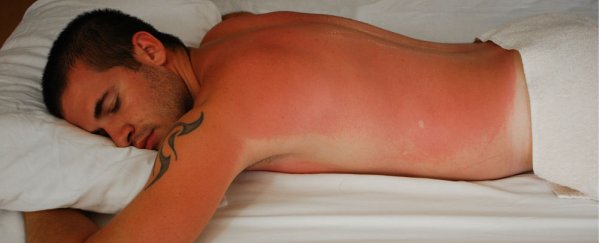You may think you're safe inside your home, or at night, but the damaging effects of sun exposure can continue even in the dark, new research suggests.
Researchers from Yale University in the US say that the majority of the potentially cancer-causing damage to skin cells that results from ultraviolet radiation (UVR) - both from the Sun and tanning beds - occurs up to four hours after exposure. And this damage to skin continues to be inflicted in the dark.
Ultraviolet radiation can damage DNA in melanocytes. These are the cells in our skin that produce the substance known as melanin, which gives our skin, eyes and hair their colour.
It was previously thought that melanin protected the skin, acting as a kind of natural barrier that scattered UVR and reduced its intensity, but the findings of this latest study, published in Science, show melanin can also have harmful effects through chemical reactions that occur long after exposure has taken place.
It's something of a double-edged sword: "The unusual chemical properties of melanin that make it a good UV absorber also make it susceptible to other chemical reactions that just happen to have the same end result as the UV," lead investigator Douglas Brash told Reuters.
In the first stage of their experiment, the researchers exposed mouse and human melanocyte cells to radiation from a UV lamp. This exposure resulted in damage to the DNA in the cells, in the form of mutations, or molecular lesions, which are considered the primary cause of skin cancer.
These mutations disrupt functions within the cell and, according to the press release, prevent information encoded in the DNA from being read correctly.
The researchers expected to see this kind of damage immediately after exposure, but were surprised to discover that the majority of the genetic mutations in melanocyte cells were produced in the dark, more than three hours after exposure.
In searching for an explanation as to how this could be, one of the team, Sanjay Premi, discovered that the UVR activated two enzymes that work together to excite an electron in melanin. This results in a process known as chemiexcitation, which is a process that occurs in certain bioluminescent plants and animals, such as fireflies, but has never been confirmed in humans - until now.
This in itself is an interesting by-product of the study, as the researchers note that their findings "validate the long-standing suggestion that chemically generated excited electronic states are relevant to mammalian biology".
The energy from this previously unobserved process essentially mimics the damage inflicted on DNA by the initial UVR exposure - only it does so several hours later, in the dark.
"People should be aware of the chemistry initiated in the skin after the UV exposure so that they can take proper care of themselves whenever going out in the sun or to the beach," Premi told Reuters.
And although the findings are somewhat disconcerting, the researchers are hopeful that new treatments could be developed to help prevent melanomas.
"We'd like to find new ingredients for sunscreens that will block these reactions," Brash says.
Source: Reuters via ABC Science
